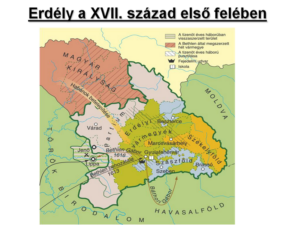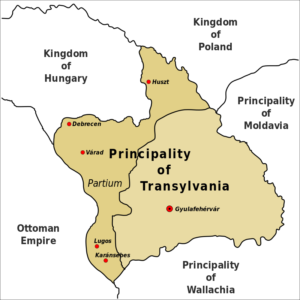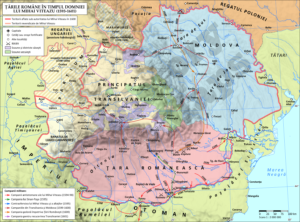The Long War, Part 35; Internal war in Transylvania 1600-1604

The first years of the 17th century were disastrous in the Principality of Transylvania. As for me, it is hard to figure out who was the most harmful villain among the contesting parties: General Basta, Prince Báthory Zsigmond, Voivode Mihai Viteazul aka Vitéz Mihály but we could add others to the list. Let us follow the summary of our historian, Szibler Gábor who is summarizing this complicated but very interesting period for us. The inserted links might be helpful to take a deeper look into events before 1600.

We have to trace back the events for a better understanding of the situation. Let’s begin with the takeover of the Wallachian voivode. The Voivode of Wallachia, Vitéz Mihály defeated the army of Prince Báthory András in the autumn of 1599 and he marched into the capital, Gyulafehérvár (Alba Iulia).
The Chief Captain of Kassa (Kosice, Kaschau), Giorgio Basta had also set out towards Transylvania but hadn’t moved into the Principality. Instead, he was taking important castles on its frontier.

Voivode Mihály was accusing him because of his late arrival, saying that Prince Báthory András had bribed him. Basta was deeply hurt by this accusation and it has greatly influenced their future relationship. The Voivode was actually the subject of Emperor Rudolf but he began to make himself detached from him, acting like a sovereign prince. His Wallachian lords appeared in his court and many of them were given high offices. Besides, he summoned a Diet and tried to balance his position between the Sublime Port and the Holy Roman Empire.

When Ungnad Dávid and Székely Mihály, the commissioners of Rudolf arrived in the first part of 1600 to take over the power and the lead of Transylvania on behalf of their lord, the Wallachian Vitéz Mihály was demanding an immense price in exchange for doing so. He also wanted to be recognized as the “eternal governor” of Transylvania but later he wanted the title of Prince of Transylvania and the Partium (a wide land between Transylvania, the Ottoman Occupied Lands of Hungary, and Royal Hungary) as well as the leader of Wallachia and Moldova. He also announced his claim for further domains and castles, including lands that were to be retaken from the Turks only in the future.

Rudolf answered him on 12 September, allowing him to govern Transylvania in his lifetime but only as a governor on behalf of the Emperor. In the meantime, the Voivode sent similar claims to the Sublime Port which sent him the symbols of princedom in exchange for this. Voivode Mihály took Moldova back from Voivode Jeremias Mohila during the spring so he established a loose personal union of the three principalities.

As the taxes in Transylvania were growing and more and more mercenaries had to be supplied in the cities, the local lords were getting restless and annoyed, all the more when they saw the growing influence of the Wallachians in the administration.
They began plotting against the Voivode and Mihály hurried to break their movement down by force before it would be strong. There were two groups of rebels, one of them was waiting for the help of Emperor Rudolf while the second was expecting the return of Báthory Zsigmond who lived as an “outcast” in Bohemia. Finally, the two groups have joined forces and turned together against the Voivode. They thought they could catch him unaware because Mihály was busy gathering troops in order to beat back an attack that was threatening him from Poland.

They pretended themselves to be the Voivode’s followers and could successfully come together on the field of Keresztes, organized by Csáky István as if they had wanted to join the Voivode’s army. In the meantime, Mihály was summoning all his Wallachian, Cossack, Serbian, and Hungarian Székely soldiers at Szászsebes and he realized just too late that the Hungarian noblemen were actually coming together against him. The Voivode sent for help to General Basta but the Hungarian rebels also sent an envoy to him, pleading for his help, too.

The Chief Captain of Kassa (Kosice, Kaschau) was instructed by the Court of Prague to march against Voivode Mihály because the Emperor had had enough of the Voivode’s growing power. The Imperial troops set out at the beginning of September and the Hungarian rebels joined them at Torda (Turda) on 14 September.
Basta had brought 6,000 mercenaries and the army of the Transylvanians was about 12,000 men. They had 4 smaller and 8 larger cannons, too. The army of Mihály was slightly bigger, it was estimated at 22,000 soldiers and he had 28-32 cannons as well.
The two armies met at Miriszló, along the Maros River, not very far from Gyulafehérvár on 18 September 1600.
After a pitched battle, the Voivode and the remains of his army have fled, losing 4-10,000 men. Basta lost a lot fewer soldiers.
Mihály has lost Transylvania and withdrew to Fogaras. Then, he gave his wife and children to Basta as hostages and moved to Moldova. Here is a more detailed article about these events:
There, in Moldova, he suffered several defeats by an allied Moldovan-Polish army and he was forced to leave even from Wallachia. Finally, he has found shelter in the court of Emperor Rudolf in Prague but his role has not been finished just yet.

Basta has taken over the governing of Transylvania but the destructions of his mercenaries had no limits. Suddenly, Báthory Zsigmond returned in 1601 (for the fourth time) and many people took his side. In the meantime, Voivode Mihály came to terms with Emperor Rudolf and he was also returning to Transylvania.
Prince Báthory was collecting soldiers to fight against the combined army of General Basta and Voivode Mihály. It is assumed that the Transylvanian army was bigger than the enemy at this point. Having collected his soldiers, his army attacked the camp of Basta at Majtény, and after this Zsigmond tried to begin talks with the General but his attempts were in vain. Then, he withdrew towards Transylvania but his army began to lose morale and the soldiers were leaving it.

The Battle of Goroszló, 3 August 1601
Basta, instead of waiting for reinforcement that was not given, hurried after Prince Báthory. The two armies met at Goroszló, not far away from Zilah on 3 August. The Imperial Army was deployed in two different units, the soldiers of General Basta and Voivode Mihály were apart, even though Basta was the chief commander. On the other hand, Báthory appointed two commanders to lead his units, Székely Mózes, and Csáky István. They had the same rank and they regarded each other as competitors.

The opposing armies could not deploy in the very narrow valley of Goroszló. Báthory wanted to prevent Basta from cutting himself through in the direction of Transylvania so he occupied the hills and placed cannons there. In the oncoming battle, the fight was mainly done by the infantry and the artillery because the cavalry had no place to go. The Imperials launched the attack and the Transylvanians were defending themselves. The struggle lasted from morning to 4-5 P.M.

Then, Báthory wanted to return to his camp and Basta would have done the same because his troops were tired and required some rest. At this point, Voivode Mihály encouraged the Imperials to renew the fight. Soon, the Imperials were attacking the retiring Transylvanian troops from three directions. Although it caused a surprise to them, they took up the fight and stood fast. The Imperials, after great efforts, were able to occupy the hills and turned the cannons toward the Transylvanians. It decided the battle.

The Transylvanians fled, they had particularly high casualties among the infantrymen, an estimated number of 1,000-3,000 men. The slaughter ceased only after sunset. Basta could gain all the cannons and flags. The victors hanged the captured Hungarian officers on 60 gallows trees on the spot.

It was how Basta and Mihály defeated Báthory Zsigmond who fled to Moldova with his remaining followers. Soon, General Basta and Voivode Mihály developed a quarrel. While Mihály`s army was sacking Transylvania, the Voivode was exchanging letters with the Turks. It meant treason for the Imperials and Basta had the Voivode murdered by his Walloon mercenaries on 19 August.

After this, Báthory`s and Basta`s private war was destroying the lands of Transylvania even further. Soon, Báthory received the Ottomans’ aid. While Basta took himself into northern Transylvania, Báthory occupied the south.
Finally, the Court of Prague has authorized Basta to offer Báthory Zsigmond the lands of Oppeln and Ratibor again. Zsigmond took the offer willingly and he was about to leave the country. He was on the way out of Transylvania when his army, led by Székely Mózes was defeated by Basta on 2 July 1602, at Tövis near Gyulafehérvár. Báthory had to say farewell to Transylvania for good, he left for Prague where he died soon. As for Székely Mózes, he fled to Ottoman territory.




Due to the great destruction caused by the mercenaries of the Imperial army, the inhabitants of the land sided with Székely Mózes. Borbély György, Toldy István, and several others immediately joined him. Then, Székely took the fort of Karánsebes, then Lugos Castle on 15 April. It was Huszár Péter who used to be the captain of Lugos, he was a very famous warrior of the Hungarian Borderland. Mózes captured him and handed the old warrior to the Crimean Tatars who executed him ceremonially and drank from his blood, for the eternal shame of Székely Mózes. You can read about the heroic life of Huszár Péter here:
https://www.hungarianottomanwars.com/essays/berenhidai-huszar-peter-a-hungarian-hero/
The Saxon town of Szászsebes fell to Székely on 15 April, too. The defenders of Gyulafehérvár surrendered on 7 May 1603. Here, Székely Mózes declared himself Prince of Transylvania. General Basta was urging the Emperor to send him supplies and money and he wrote to his ally, Voivode Radu of Wallachia to come to his aid. As nothing happened, Basta was slowly forced out of Transylvania and had to take up positions in the lands of the Partium. The army of Prince Székely and Pasha Bektás has taken almost the entire Transylvania. They took Kolozsvár (Klausenburg, Cluj) on 9 June, then Beszterce and Medgyes on 25 June. Behold, they were joined by lots of Hungarian Székely Frontier Guardsmen. Read about the Székelys here:
https://www.hungarianottomanwars.com/essays/who-were-the-szekelys/
Prince Székely Mózes told the Voivode of Moldova, Jeremiás Moghila to join him to tie down Voivode Radu. Moghila showed his willingness. At the same time, Székely Mózes talked with Radu as well and offered him the Turks’ help who would affirm his rule if he didn’t attack him. Voivode Radu pretended to have taken this offer but as it turned out, he just wanted to gain time.

Then, Radu sent a 3,000-strong army in June to Transylvania, led by Deli Marko (Merya) against Mózes. Radu did not join this army because he stayed back to fend off an eventual Moldavian attack. Seeing Deli Marko’s army, Prince Székely Mózes sent a 4-5,000-strong-army from Segesvár (Sighișoara, Schäßburg), led by Makó György to the Barcaság area. Their vanguard clashed with the Wallachian soldiers who were aided by the Hungarian Székely Guardsmen on 11 July near Brassó (Brasov, Kronstadt). There was minimal loss on both sides.
The Wallachian army slowly began to retreat and Makó attacked them on 13 July. The Wallachian-Székely army was defending from a fortified position, then they launched a counter-attack. The Transylvanians had huge losses, about 3,000 men while the Wallachian-Székely army had only 300 casualties. Even Makó György fell in the fight.

The Battle of Brassó, 17 July 1603
At the same time, Prince Mózes and Pasha Bektás marched to Brassó (Brasov, Kronstadt) and Voivode Radu arrived there as well. He would have agreed to make a truce but his noblemen were against the Turk’s dependence and forced him to hold a battle. The Battle of Brassó took place on 17 July and both sides sent about 10,000 men there to fight. The camp of Székely Mózes was defended by a wagon fort and his allies, the Turk and Crimean Tatar troops stood on his right wing.

The Crimean Tatars were the first to flee and the enemy could easily attack the camp of Prince Székely Mózes. There was a hard fight but the enemy could break in and make a horrible slaughter among the Transylvanian troops. The forces supporting Székely Mózes suffered 3-7,000 casualties. The casualties included famous noblemen like Bogáthy Miklós, Toldy István, Szentpály János, Perusich Máté, and the five Apor brothers. Bogáthy Menyhért and Bethlen Gábor (later prince of Transylvania) were lucky to escape with a small unit, they ran to Déva castle. Pasha Bektás had to throw away his expensive coat just to flee faster.

The fleeing prince was killed and his head was placed on the top of the bastion of Fogaras Castle. It was buried later by the Chief Judge of Brassó, Mihály Weisz. After this, Voivode Radu returned to his country but allegedly he received a flag and the rank of an Imperial prince from King Rudolf who has achieved by this time to be the only ruler of Transylvania. Was he able to hold it? It remains to be seen. One thing was for sure, the 15-Year-War has not just been finished.

Source: Szibler Gábor and Bánlaky
Here is a previous article that is connected to these events:

